It’s been a roller-coaster journey, but the Anaheim Ducks managed to qualify for the postseason for the sixth consecutive year. They will even have home-ice advantage in the first round after that notion seemed like a pipe dream for the majority of the season, which saw an injury-ravaged team flirting with the possibility of missing the playoffs altogether.
Even with home ice, the Ducks face a tough opponent in Round 1: the San Jose Sharks. Despite being long-time division and in-state rivals, the two teams have only met in the postseason once, and that was nine years ago. The Ducks came away with a shocking six-game defeat of the Presidents’ Trophy-winning Sharks in the first round that year.
Much has changed nearly a decade later, but one thing that hasn’t is the likelihood of another tightly-contested series. Here is some background on the Ducks and their opponent, as well as some things to look for in the series that commences this Thursday, April 12, at Honda Center in Anaheim.
Comparing the Ducks & Sharks
Below are each team’s statistics in select metrics across the 2017-18 regular season.
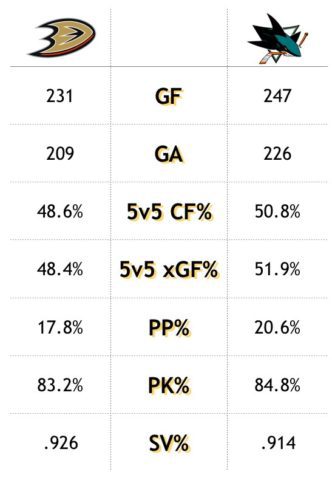
The Ducks had their share of ugly moments this season, often struggling in the possession department. The Sharks, on the other hand, put up more respectable possession metrics. The great equalizer for the Ducks—especially when they were simply trying to stay afloat early in the season when the injury bug was at its worst—was superior goaltending. Their team save percentage—spearheaded by John Gibson—was a stellar .926. Between Martin Jones and Aaron Dell, San Jose had a .914 save percentage as a team, right in line with the league average of .912.
From a special-teams perspective, the Sharks held a clear edge with respect to power-play efficacy, as their 20.6-percent success rate, while only 16th in the league, was much better than the Ducks’ 23rd-ranked mark of 17.8 percent. A critical factor worth noting, however, is that San Jose’s power play was much more effective before playmaking wizard Joe Thornton went down with a torn MCL. Through Jan. 23—the last time Thornton suited up this season—the Sharks were humming along at a 22.7-percent clip with the man-advantage. Since then? A stark drop to 16.5 percent. Thornton projects to miss this series as well.
On the other side of special teams, both clubs had an excellent penalty kill. The Sharks ranked second in the league with an 84.8-percent kill rate while the Ducks were not far behind at 83.2 percent (fifth in the league).
Despite the Ducks’ uneven play for much of the regular season, they had a strong finish. The Sharks turned it on in March but had a weaker finish, losing five of their last six games and thus ceding home-ice advantage in the first round.
For the Ducks, it truly was an up-and-down season, shown below in literal fashion with respect to their expected goal differential. Anaheim will hope to ride the current upswing through this series and perhaps beyond.
Head-to-Head Regular-Season Results
For what it’s worth, the Sharks won three of four regular-season meetings with the Ducks. Two of those victories (2-1 on Nov. 4 and 3-2 on Feb. 11) were in a shootout, though, while the Ducks’ lone win also came in a shootout (3-2 on Nov. 20). Thankfully, the shootout is not a thing in the playoffs.
The teams’ last meeting on Feb. 11 had to have left a sour taste in the Ducks’ mouths, as they squandered a 2-0 third-period lead before falling in the shootout. Anaheim was less than a minute away from a win, but the Sharks, down 2-1, tied it with 53.7 seconds to go as Timo Meier redirected Logan Couture’s perfect shot-pass.
Excluding shootout goals, San Jose outscored Anaheim 11-7 across the four games and also had a decisive edge in 5-on-5 shot attempts (216-190) and overall shots on goal (152-118). Those shot metrics are even more lopsided when taking into account the score effects from the Sharks’ blowout 6-2 win in Anaheim on Jan. 21, as the Ducks ended up with more shots and attempts in that game largely as a function of being down by multiple goals.
On special teams, the Ducks scored just one power-play goal in seven attempts against San Jose’s excellent penalty kill. The Sharks had more attempts (12) and made good on three of them as they were able to find some luck against Anaheim’s solid PK. Make what you will of the small sample sizes.
In many ways, the regular-season results between these two teams do not mean much now, but one thing Anaheim can take away from it is the need to tighten up, as they gave up an average of 38 shots per game against the Sharks.
Ducks Players to Watch and Keys to Series
For the Ducks, their biggest strength is in net. Gibson, their unofficial team MVP, should be back from his upper-body injury in time for Game 1. Even if he weren’t ready for that game, they’d be in good shape with backup Ryan Miller. Veteran defenseman Kevin Bieksa might also be back, even though that might not be vital for the Ducks beyond giving them more depth in the event of further injury. Go-to blueliner Cam Fowler, however, will be out of the lineup.
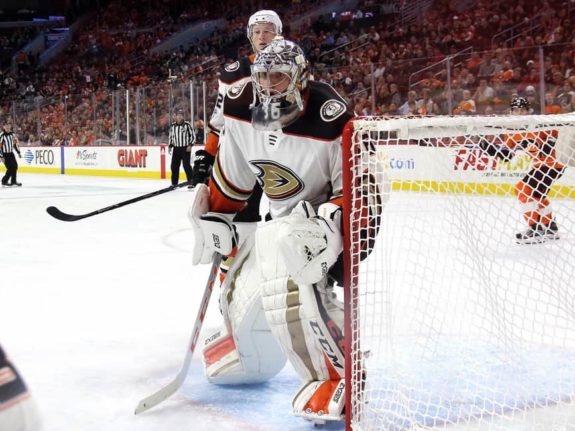
Without Fowler, Anaheim will have to lean heavily on Hampus Lindholm and Josh Manson, its two most consistent defenders over the course of the year. The duo provides stability for a club that struggled to find that for most of the season, as they are the only two Anaheim blueliners with a 5-on-5 Corsi-for above 50 percent. Brandon Montour, Francois Beauchemin, and Marcus Pettersson will also be counted on to elevate their roles. Depending on Bieksa’s availability, the inexperienced Andy Welinski could also see some time, along with Korbinian Holzer.
Despite the sub-optimal state of their defense, the Ducks will still ice three defensemen who eclipsed the 30-point plateau in Lindholm, Manson, and Montour. For a team that does not score at a prolific rate and has a weak power play going up against an elite penalty-killing unit, getting offensive contributions from the blue line will go a long way in determining their success in this series.
The Ducks will also continue to lean heavily on leading scorer Rickard Rakell, who put up a career-high 34 goals and 69 points in the regular season. His chemistry with Ryan Getzlaf, who had 50 assists in just 56 games, has been tough for opponents to neutralize. Breakout youngster Ondrej Kase and trade acquisition Adam Henrique—both of whom scored 20 goals with the Ducks (the latter in just 57 games after the trade)—will also be counted on for secondary scoring, along with Jakob Silfverberg (17 goals, 23 assists) and Andrew Cogliano, who finished the season strong to end up with 12 goals and 23 assists.
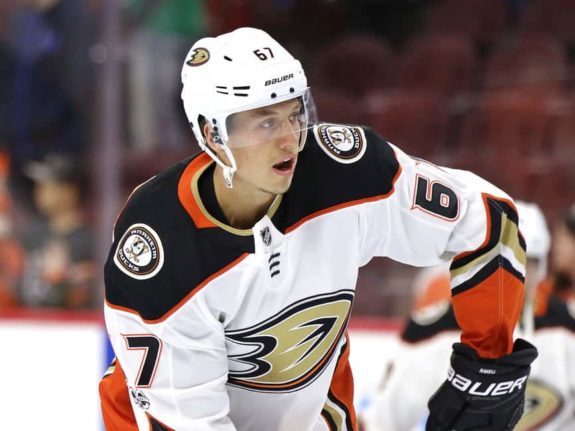
Longtime star Corey Perry has seen a dip in his production the last couple of years but has still hovered around the 50-point mark and is a likely candidate to raise his game in the postseason. Ryan Kesler has been battling back from a hip injury all year and clearly has not been at 100 percent (he scored just eight goals and six assists in 44 games), but with Henrique bolstering their center depth, the Ducks can leverage Kesler more as a defensive and faceoff specialist.
At the end of the day, the biggest keys for Anaheim in this series will be for Montour and Beauchemin to provide stability behind Lindholm and Manson while Fowler is out, for the blue line to chip in offensively, and for the depth scoring to provide a consistent punch. Stellar goaltending has been the main ingredient in their success all year, but between Gibson and Miller, that is already a known quantity (please, let’s not dive into, “Can Player X get it done in the playoffs?” narratives).
Montour can provide offense, and the eye test tells us that the veteran Beauchemin has had an extra spring in his step during the latter stages of the season, but both players have struggled in suppressing offense from their opponents. The opposition accumulates shot attempts at a rate of 59.6 per 60 minutes (so basically one shot attempt per minute) when Montour is on the ice in 5-on-5 situations. For Beauchemin, the rate is worse (62.7). Given that they’ll likely be seeing more minutes until Fowler returns, their ability to mitigate that issue in this series and beyond will be crucial.
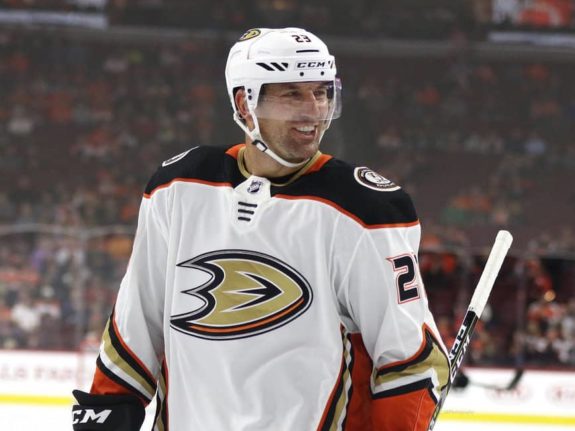
Sharks Players to Watch and Implications
Even without Thornton, the Sharks still bring a good amount of bite offensively. Their leading scorer came from the back end, as Brent Burns amassed 67 points, including 55 assists. Captain Joe Pavelski put in another solid year with 66 points, even if he fell short of the 30-goal mark he has so frequently hit in his career (he had 22 this season). Seven of his 22 tallies came on the power play, and he is arguably the best player in the league at deflecting shots from the slot or net-front area. Anaheim’s defenders will have to effectively box him out of those areas and tie down his active stick (without taking a penalty, of course).
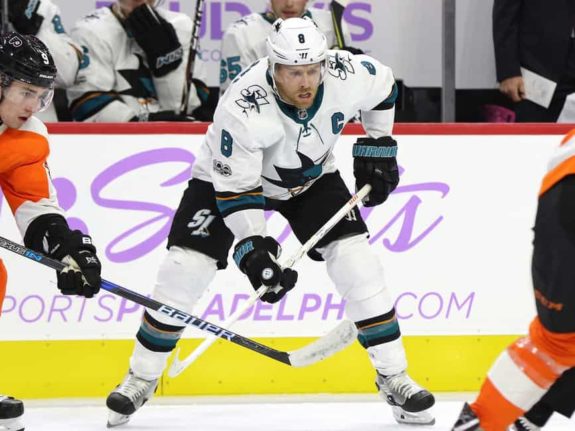
Net-front defense has not been a particular strength for the Ducks this year, and the Sharks actually exploited that weakness with their last-minute tying goal in the Feb. 11 game. Players like Pavelski and the 21-year-old Meier—who scored that tying goal on Feb. 11 and became a major contributor to the Sharks’ success with 21 goals—will feast on the Ducks if that area is not locked down defensively.
Couture led San Jose with 34 goals while Tomas Hertl tied Pavelski for second on the team with 22. From the back end, the Sharks also got some offense from players other than Burns, as Marc-Edouard Vlasic and Justin Braun each poured in over 30 points (including 11 goals for Vlasic and 28 assists for Braun). The duo also comprised the Sharks’ most frequently deployed defensive pair, although their poor possession numbers (45.94-percent Corsi at 5-on-5 and over 62 shot attempts against per 60 minutes) could spell opportunities for the head coach Randy Carlyle and the Ducks to establish some pressure in San Jose’s end with the right matchups.
A major X-factor for the Sharks could be forward Evander Kane. Acquired from the Buffalo Sabres at the trade deadline, the 26-year-old clicked immediately in San Jose, scoring nine goals and five assists in just 17 games, highlighted by a four-goal effort in Calgary on March 16. With Kane on board, the Sharks reeled off eight straight wins in March to solidify their playoff spot. He missed a couple of games late in the season due to injury, but he was back for San Jose’s regular-season finale and thus should be good to go for Game 1 against the Ducks.
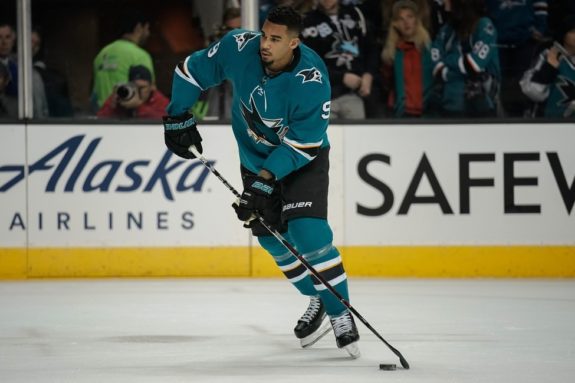
Beyond Kane, the Sharks boast a great deal of depth up front. In addition to the players mentioned, Chris Tierney, Kevin Labanc, Mikkel Boedker, and Joonas Donskoi all scored over 30 points. Matching up against them will not be an easy task for the Ducks and their weakened blue line.
In goal, the Sharks have a solid starter in Martin Jones, who put up a .915 save percentage in 60 starts. Despite that, there was some inconsistency in his game. He experienced some struggles late in the year, as his save percentage since March 1 dropped down to a meager .908 while he started 16 of the Sharks’ final 20 games. In addition, across the whole season, his goals-saved-above average-per-60 was in the negative. The Ducks will need to test Jones as much as they can to see if they can take advantage of his recent rough patch.
Series Prediction
The Sharks hold a statistical edge in several areas and are generally able to create more offense than the Ducks. They will undoubtedly give the Ducks some fits with their scoring depth and shot generation (their 4,045 shot attempts at 5-on-5 were the fourth-most in the NHL and dwarfed the Ducks’ 22nd-ranked total of 3,653).
Anaheim, though, has a major edge between the pipes and is playing some of its best hockey of the season, averaging 3.28 goals per game since March 1 (compared to 2.69 prior to that date). Riding into the playoffs on a high note and with a battle-tested group (even without Fowler) should help. It will be a tight series, but in the end, there is something to be said about the Ducks being in this position despite all that they’ve had to endure this season.